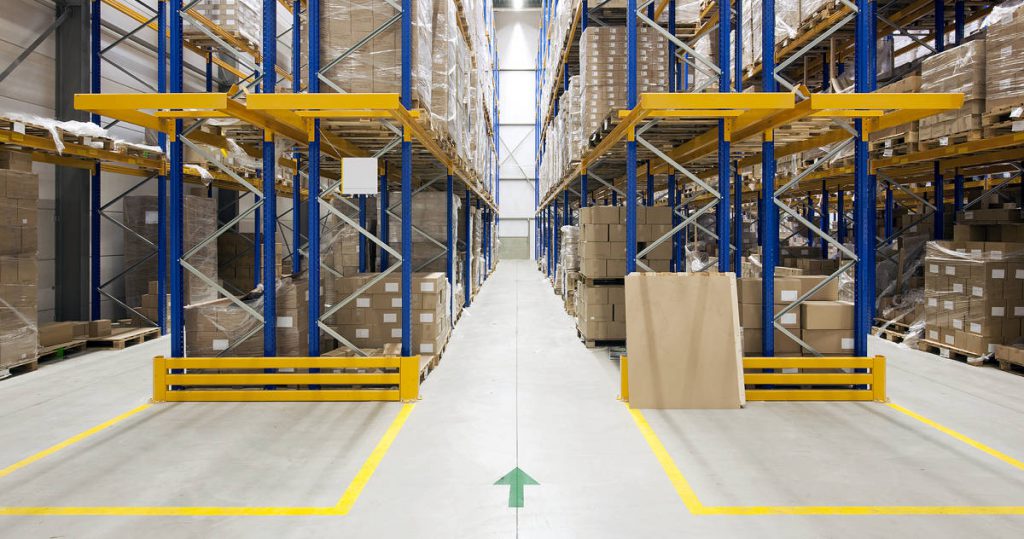There are three considerations for side-spacing on a pallet rack beam: fire suppression (flue), aisle dimension, and material handling equipment straddling requirements.
Fire suppression – flue spacing
Pallet rack is usually designed around the width of grocery pallets. A pallet rack beam is designed for each pallet width x (times) 2 or 3 pallets wide with a minimum of 4″ of flue spaces side to side to allow for sprinklers to douse flames between pallets.
Therefore a 144″ beam has 3 x 40″ wide (standard grocery) pallets with 6″ spaces between the pallets and the upright (4 x 6″).
A 96″ beam has 5.3″ spacing.
Fire engineers are looking for 4″ spacing between pallets (side-to-side and back-to-back) in order for the sprinkler system to work properly. On an annual fire inspection, a fire chief might flag a tightly loaded pallet rack beam as not having enough room for the sprinklers to cascade water to the lowest level. The fire chief may ask you to increase side-spacing and to put a physical barrier on the beam to ensure not encroachment of product into the flues around the pallets.
Aisle dimension
Based on the length of the forklift truck and the side-spacing on the beam, an aisle dimension is calculated. With more side-spacing the aisle can be narrower. Think of a car parking lot where the parking spaces are narrow. As long as you have a long approach, you can park in a narrow parking spot. If you don’t have a long approach, you can still park the car in a wide parking spot, assuming you can pivot into place. The same principle applies to forklift trucks.
If you find yourself with limited aisle spacing, increase the side-spacing on the beam (buy a longer beam) to allow for better lift truck maneuverability. If you have limited side-spacing on the beam, you will need a wider aisle for the lift truck to store and retrieve pallets.

A Straddle Stacker requires side spacing
A straddle stacker is a popular type of material handling lift truck for parts rooms and back-room storage areas. They require side-spacing around the pallet they are picking up to straddle the pallet. If the pallet is 40″ wide, then the straddle baselegs (outriggers) are set with a 42″ baseleg opening (ID) and with an outside dimension of 10″ greater (5″ per side) to accommodate the width of the outriggers. For clearance with the upright pallet rack frame baseplate and the frame, an additional 1″ is required on the outside of the outrigger. Therefore, between baseplates, and minimum distance of 3 x 7″ of side-spacing is required for two pallets stored on the beam, and 4 x 7″ for three pallets stored on the beam. For typical grocery storage in a non-seismic zone, a 101″ beam is required, but a 108″ beam is more standard. For a seismic zone with wider footplates a 106″ beam is required, but a 108″ beam is commonly used.
For three grocery pallets stored side-by-side using a straddle stacker, 153″ is required, and a 156″ beam is commonly used.
Pallet Rack Elevation for Reach Trucks
A common mistake when designing pallet racking for a reach truck is failure to specify a reach truck with straddle outriggers (baselegs) or a failure to provide enough ground-level lift off so you can pick up a pallet to retract overtop of the baselegs.
Here are two reach truck rack elevations. One shows a bottom beam with enough clearance under the first beam to allow the 5” high baselegs to slide under the racking.
The option is to provide lift off for the pallet be lifted high enough to be retracted over the baselegs.
The third option is to ensure the baselegs have an inside dimension that is at least 1”-2” wider than the widest load. Notice we did not say widest pallet. In the case of sacks of rice, flour, or cornmeal, sagging loads over the pallet will brush up against the baselegs causing damaged product and a mess to clean up.
Here is a typical reach truck elevation UNLESS the inside dimension between the outriggers is at least 1 or 2 inches wider than the width of the pallet you are picking up. Otherwise, you need a much wider aisle or more ground-level lift-off, or a 10″-12″ high bottom beam (depending on the weight of the pallet and the beam deflection).
Typical Racking Design for Reach Trucks
Full-Service Rack Company
Need help with racking design, supply, and racking installation? Here is a great company that does great work: Lean Inc. based in Anaheim, California.
Address:
Lean Materials Handling
1950 W Corporate Way, PMB 12217,
Anaheim, CA 92801
T: (714) 485-8739
E: info@think-lean.com


